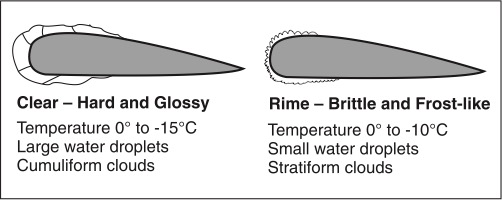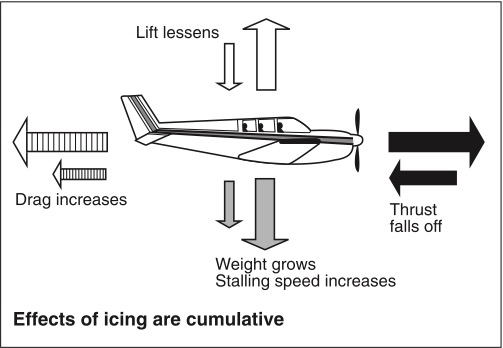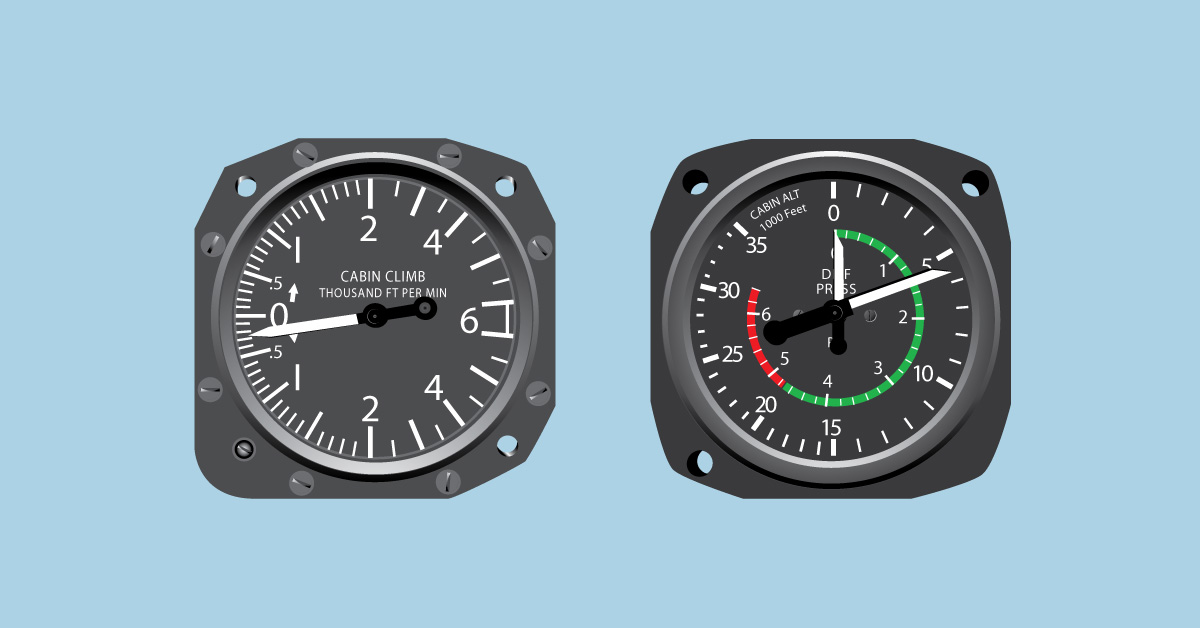Ice sucks, unless of course you are a hockey player, figure skater, or just want a nice, cold, tasty beverage. But in terms of aviation, ice sucks. In general, icing is any deposit of ice forming on an object. In aviation icing is considered to be one of the major weather hazards affecting flight. We refer to icing as a cumulative hazard, meaning the longer an aircraft collects structural icing the worse the hazard will become. Structural icing is the stuff that sticks to the outside of the airplane, it occurs whenever supercooled condensed droplets of water make contact with any part of the airframe that is also at a temperature below freezing. An inflight condition necessary for structural icing to form is visible moisture (clouds or raindrops). Structural icing is categorized into three types: Rime, Clear, and Mixed.
Rime Ice
Rime ice is rough, milky, and opaque ice formed by the instantaneous freezing of small, supercooled water droplets after they strike the aircraft. It is the most frequently reported icing type. Rime ice can pose a hazard because its jagged texture can disrupt an aircraft’s aerodynamic integrity.
Rime icing formation favors colder temperatures, lower liquid water content, and small droplets. It grows when droplets rapidly freeze upon striking an aircraft. The rapid freezing traps air and forms a porous, brittle, opaque, and milky-colored ice. Rime ice grows into the air stream from the forward edges of wings and other exposed parts of the airframe.
Clear Ice
Clear ice (or glaze ice) is a glossy, clear, or translucent ice formed by therelatively slow freezing of large, supercooled water droplets. Clear icing conditions exist more often in an environment with warmer temperatures, higher liquid water contents, and larger droplets.
Clear ice forms when only a small portion of the drop freezes immediately while the remaining unfrozen portion flows or smears over the aircraft surface and gradually freezes. Few air bubbles are trapped during this gradual process. Thus, clear ice is less opaque and denser than rime ice. It can appear either as a thin smooth surface, or as rivulets, streaks, or bumps on the aircraft.
Clear icing is a more hazardous ice type for many reasons. It tends to form horns near the top and bottom of the airfoils leading edge, which greatly affects airflow. This results in an area of disrupted and turbulent airflow that is considerably larger than that caused by rime ice. Since it is clear and difficult to see, the pilot may not be able to quickly recognize that it is occurring. It can be difficult to remove since it can spread beyond the deicing or anti-icing equipment, although in most cases it is removed nearly completely by deicing devices.
Mixed Ice
Mixed ice is a mixture of clear ice and rime ice. It forms as an airplane collects both rime and clear ice due to small-scale (tens of kilometers or less) variations in liquid water content, temperature, and droplet sizes. Mixed ice appears as layers of relatively clear and opaque ice when examined from the side.
Mixed icing poses a similar hazard to an aircraft as clear ice. It may form horns or other shapes that disrupt airflow and cause handling and performance problems. It can spread over more of the airframe’s surface and is more difficult to remove than rime ice. It can also spread over a portion of airfoil not protected by anti-icing or deicing equipment. Ice forming farther aft causes flow separation and turbulence over a large area of the airfoil, which decreases the ability of the airfoil to keep the aircraft in flight.
Effects of Icing
Remember when I said a few paragraphs earlier that ice sucks? Well I didn’t really explain myself as to why.
When structural icing forms, it reduces aircraft efficiency by increasing weight, reducing lift, decreasing thrust, and increasing drag. Each effect will either slow the aircraft or force it downward. As ice accumulates the performance characteristics of the aircraft will continually deteriorate eventually to a point where the aircraft can no longer maintain sustained flight and stalls. The image below is a good depiction of this.
As ice forms on an airfoil, it will destroy the smooth flow of air over the surface of the wing resulting in drag and diminishing the maximum lift capable of the wing. NASA wind tunnel testing has shown that icing on the leading edge or upper surface of a wing no thicker then coarse sandpaper can reduce lift by 30 percent and increase drag by 40 percent.
In addition icing can also cause instrumentation errors, frozen or unbalanced control surfaces, engine failures and/or structural damage due to chunks of ice breaking off.
Additional Knowledge to Know
- Icing in precipitation (rain) is of concern to the VFR pilot because it can occur outside of clouds.
- Aircraft structural ice will most likely have the highest accumulation in freezing rain which indicates warmer temperature at a higher altitude.
- The presence of ice pellets at the surface is evidence that there is freezing rain at a higher altitude, while wet snow indicates that the temperature at your altitude is above freezing.
- A situation conducive to any icing would be flying in the vicinity of a front.







